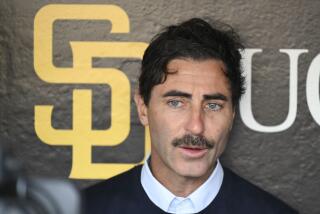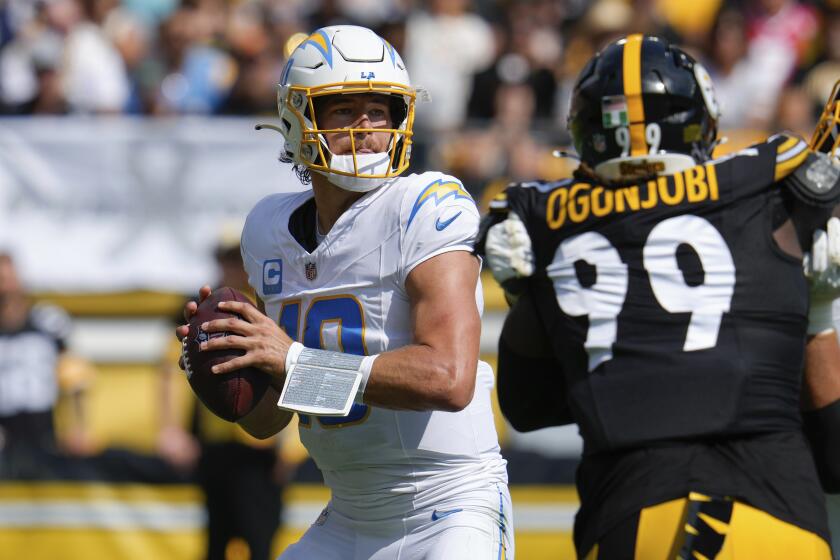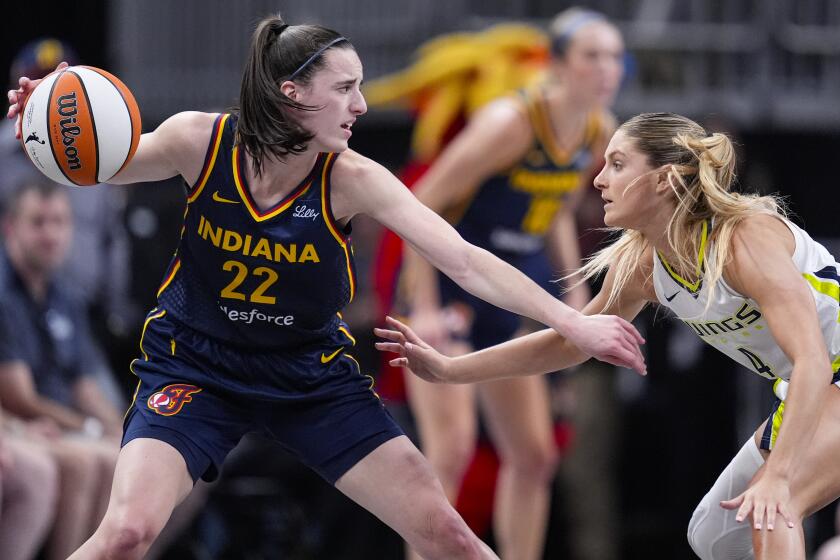The unlikely big man in baseball’s drug scandal
Kirk Radomski was a batboy, a towel attendant, a clubhouse hanger-on. Then he bulked up one winter and offered his idols what investigators term a more specialized and sought-after service -- scoring steroids.
And that would quietly make Radomski one of the most influential people in major league baseball.
Now a Long Island, N.Y., auto detailer and admitted felon, Radomski is the star witness in the Mitchell Report, exposing in lurid detail his word-of-mouth network of alleged steroid customers that started with his former employer, the New York Mets, and quickly spread across the landscape of America’s pastime.
On Friday, a day after the report’s release, the magnitude of Radomski’s role in the steroid investigation became more and more evident, as his sordid accounts echoed through team front offices and turned up the volume on demands for reform.
Radomski, 37, kept such players as Lenny Dykstra, Roger Clemens and Paul Lo Duca supplied with overnight shipments of steroids and human growth hormone, dispatched to homes, hotels and stadiums, earning him as much as $600 a pop, the report says.
But then federal agents turned up at his door, and Radomski’s long run as baseball’s biggest known juice dispenser came to end -- even as his canceled checks, telephone records and address book helped launch baseball’s ugliest scandal since the Black Sox era.
Not that Radomski fits the picture of a present-day Arnold Rothstein, the dapper hoodlum and gambler who paid members of the Chicago White Sox to throw the 1919 World Series. The report suggests Radomski drifted into baseball in 1985 as a fan rather than a fixer -- just another teenage “clubbie” who got his foot in the door because he knew former Mets equipment manager Charles Samuels, a neighbor.
The kid with the shy manner would become a locker-room regular, taking volunteer or low-paying jobs fetching bats and uniforms and minding the training gear, and becoming close to some players after he was invited to spring training in 1988.
As he reached his early 20s, Radomski dreamed of becoming a competitive bodybuilder, which led him to the world of steroids. In the spring of 1993, the report says, a newly muscle-bound Radomski showed up for spring training, transformed into a walking advertisement for what would soon become his calling card.
“Many players noticed and asked him about his size and training program,” the document says. “He told them he was using steroids as part of his training regimen.”
That was all some of the players needed to hear, beginning with Dykstra, who had confided in Radomski four years earlier that he had used steroids, according to the report. Coming off a losing World Series in 1993, it states, the outfielder, then with the Philadelphia Phillies, asked Radomski to find him some performance enhancers, and the young man obliged with quantities of Deca-Durabolin, Dianabol and testosterone, some bought at local gyms.
Just like that, a coast-to-coast enterprise was born, one that would be eagerly patronized by All-Stars, MVPs and Cy Young Award winners.
Another of Radomski’s early customers was Mets first baseman David Segui, who bought steroids from him more than a dozen times, paying by personal check, the report alleges. Segui later introduced Radomski to Baltimore Orioles outfielder Larry Bigbie during an Orioles trip to New York. Bigbie, who is cooperating with federal investigators, began buying from Radomski in 2003, the report says.
Montreal Expos catcher Tim Laker also met Radomski through Segui and made cash or money-order payments of $1,000 to $2,000 for testosterone, as well as syringes, delivered to his hotel or California home, the report alleges.
By then, Radomski’s distribution pipeline was snaking through both leagues. Baseball’s limited drug testing program proved no impediment.
“Radomski continued to make significant sales of steroids, human growth hormone and clenbuterol after drug testing was in place,” the report says. “Radomski’s customers referred their friends and teammates to him as they moved from club to club.”
Todd Hundley got to know Radomski while playing in the minors for the Mets. In 1996, he bought steroids from Radomski on several occasions, and would refer Lo Duca to him after joining the former Dodgers catcher in the Los Angeles organization, the report says. Lo Duca allegedly became the Dodgers’ drug connection, arranging shipments and dashing off friendly notes to Radomski.
The Radomski client list grew to include Hal Morris, Jason Grimsley, Glenallen Hill, Denny Neagle, Mo Vaughn and Brian McNamee, a former New York Yankees bullpen catcher and conditioning coach, the report says.
Like Radomski, McNamee has reached a plea agreement with federal prosecutors and is cooperating with investigators. He told authorities that he injected Clemens with steroids while both were with the Toronto Blue Jays. McNamee followed Clemens to the Yankees as a trainer, and allegedly found a new testosterone supplier for the pitcher -- Radomski, whose name he got from Segui.
“According to McNamee, during the middle of the 2000 season Clemens made it clear that he was ready to use steroids again,” the report says. “During the latter part of the regular season, McNamee injected Clemens in the buttocks four to six times with testosterone from a bottle labeled either Sustanon 250 or Deca-Durabolin that McNamee had obtained from Radomski.”
McNamee is also identified in the report as the conveyor of Radomski-supplied HGH to Andy Pettitte and Chuck Knoblauch.
“Knoblauch paid Radomski through Jason Grimsley and, once or twice, through McNamee,” the report says.
Radomski had long since left the Mets, deciding he could make more money as a personal trainer, particularly with the illicit workout aids he offered.
For 10 years, he juggled a cross-country exchange in steroids, HGH and cash, with packages virtually passing each other on their way to and from major league cities. Thanks in part to Lo Duca, the report says, Radomski kept the Postal Service busy with shipments to Dodgers Eric Gagne and Kevin Brown, among others. He also sold his “stuff” to then-Yankee David Justice shortly after the 2000 World Series, the report alleges.
Sometimes, Radomski delivered, such as when he dropped off an HGH kit at Mets pitcher Mike Stanton’s locker in 2003, picking up $1,600 in cash, the report says. He also personally brought steroids and HGH to Rondell White when the journeyman outfielder lived in New York, according to the report.
Meanwhile, in the wake of the BALCO case in San Francisco, federal agents were casting a wider and wider net for baseball’s juicers. A tipster reportedly led them to Radomski in 2005. In a sting operation, Radomski allegedly mailed steroids to undercover agents, and they raided his home. In April, he pleaded guilty to one count of steroid distribution and another of money laundering. Prosecutors have agreed to recommend a lenient sentence in exchange for his naming names.
And though Radomski’s name is laced throughout the 409-page Mitchell Report, its authors stress that he was not alone: “Plainly he was not the only supplier of illegal substances to major league players.”
--
More to Read
Go beyond the scoreboard
Get the latest on L.A.'s teams in the daily Sports Report newsletter.
You may occasionally receive promotional content from the Los Angeles Times.











